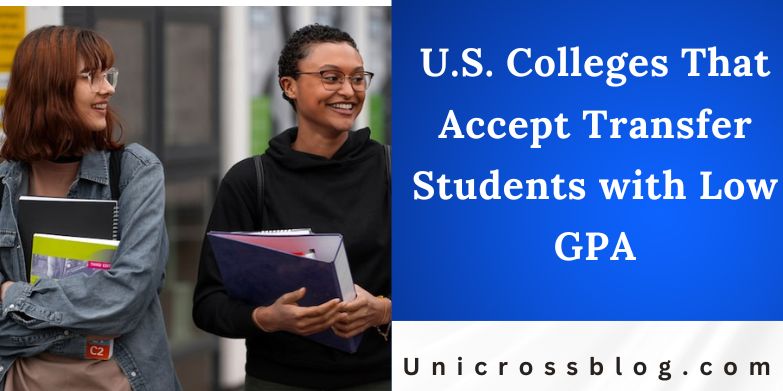Transferring to a new college can feel daunting, especially if your college GPA is below the typical 3.0 threshold that many selective universities expect. Life happens: personal challenges, mismatched programs, financial pressures, or simply adjusting to the demands of higher education can lead to grades that do not reflect your true potential. The good news is that a low GPA does not have to end your educational journey. Numerous U.S. colleges and universities welcome transfer students with GPAs as low as 2.0 or even lower, often through holistic admissions processes that consider your growth, personal story, and recent performance. These institutions recognize that students evolve and deserve second chances. In fact, about one-third of undergraduates transfer at some point, and many do so successfully despite earlier setbacks.

Why Colleges Accept Low-GPA Transfers
Colleges that accept transfers with lower GPAs typically prioritize accessibility and diversity in their student body. Public institutions, for instance, often serve in-state residents and have lower barriers to entry compared to elite private schools. Community colleges dominate this space with open-enrollment policies, allowing anyone with a high school diploma or GED to enroll, regardless of prior grades. From there, you can build a stronger transcript and transfer to a four-year school via guaranteed agreements, known as articulation pathways.
Regional or branch campuses of larger state systems also stand out. These smaller outposts offer the prestige of a big university name but with less competition. For example, they might admit students based on recent community college work rather than your full academic history. Private colleges, while rarer in this category, sometimes emphasize holistic reviews, weighing essays and recommendations heavily.
Key factors influencing acceptance include your cumulative college GPA (often a minimum of 2.0), the number of credits attempted, and your major. Engineering or nursing programs tend to be stricter, requiring 2.5 or higher, while liberal arts or general studies tracks are more forgiving. Conditional admission is common: you might start on probation but gain full status after one strong semester.
Strategies for a Successful Transfer Application
Even with a low GPA, you can boost your odds by focusing on controllable elements. Start by improving your recent grades. Enroll in a community college for a semester or two to demonstrate upward momentum. Admissions officers love seeing a 3.5 in your latest term after a 2.0 overall.
Craft a compelling personal statement. Explain extenuating circumstances briefly, such as family issues or health challenges, but pivot to how you have grown. Highlight specific actions, like seeking tutoring or joining study groups. Avoid dwelling on excuses; emphasize your readiness for the new environment.
Secure strong letters of recommendation from professors who can vouch for your potential. A note from a mentor detailing your work ethic can outweigh numbers. If possible, include extracurriculars or work experience that show transferable skills, like leadership in a club or reliability in a job.
Research transfer-friendly schools using tools like the National Student Clearinghouse or state education department sites. Apply to a mix: five to eight options, including safeties (open-enrollment) and reaches (2.5+ minimums). Deadlines vary, but fall transfers often close in March, spring in October. Submit official transcripts early and check credit transfer equivalencies to avoid losing earned units.
Financial aid is another angle. Many of these schools offer merit scholarships for transfers or in-state tuition breaks. Federal aid requires a 2.0 to maintain eligibility, so aim to meet that threshold. Finally, connect with admissions counselors. A quick email or call can clarify policies and signal your interest.
Highlighted U.S. Colleges Accepting Low-GPA Transfers
Here are some standout U.S. colleges that routinely accept transfer students with GPAs below 3.0. These selections draw from public systems, community colleges, and regional campuses, emphasizing affordability and transfer success rates.
California State University, Los Angeles (Cal State LA) is a prime example in the Cal State system, which guarantees admission to eligible community college transfers with a 2.0 GPA. Located in urban Los Angeles, it offers diverse programs in business, education, and engineering. With an acceptance rate over 50 percent for transfers, it values in-state applicants and provides robust support like free tutoring centers. Graduates often praise the vibrant campus life and career placement services.
Another strong option is the University of North Carolina at Greensboro (UNC-Greensboro). This public university accepts transfers with a 2.0 minimum, prioritizing those from partner community colleges. About 38 percent of its students are transfers, many arriving with modest GPAs but excelling in fields like nursing, arts, and social work. The school emphasizes holistic review, considering your essay and recommendations. Its affordable in-state tuition and high retention rate make it ideal for rebuilding confidence.
Florida Atlantic University (FAU) in Boca Raton welcomes transfers with a 2.5 GPA, but exceptions exist for lower scores via appeals or conditional entry. Known for marine science and business, FAU has articulation agreements with Florida’s 28 community colleges, easing credit transfers. The campus buzzes with research opportunities and beachside vibes, helping students thrive post-transfer.
For Midwesterners, Indiana University Northwest in Gary offers open pathways for transfers with a 2.0 GPA and an 79 percent acceptance rate. Part of the IU system, it focuses on health sciences and education, with small classes fostering personal growth. Financial aid covers most students, and the urban location connects you to Chicago job markets.
Community colleges shine as entry points. Hinds Community College in Mississippi has open admissions and an average incoming GPA around 2.25. It boasts over 70 programs, including strong STEM and allied health tracks, with seamless transfers to universities like Mississippi State. Santa Fe College in Gainesville, Florida, similarly operates on open enrollment, partnering with the University of Florida for guaranteed spots after two years. Its average GPA hovers at 2.75, but lower scores are fine; hands-on labs and transfer advising keep students on track.
Dutchess Community College in New York’s Hudson Valley accepts all applicants and facilitates moves to SUNY schools with GPAs as low as 2.0. Affordable and scenic, it excels in liberal arts and technical fields, with small classes aiding recovery from past struggles.
On the private side, Sullivan University in Kentucky practices open admissions for its business and culinary programs. With GPAs often below 2.5, students appreciate the career-focused curriculum and high financial aid rate (93 percent). Metropolitan College of New York in Manhattan takes a holistic approach, admitting transfers around 2.0 for urban studies and public affairs, emphasizing real-world internships over grades.
University of Washington Tacoma rounds out the list with a 2.75 average but flexibility for 2.0 transfers. This branch campus delivers UW quality in a smaller setting, with 85 percent acceptance and strengths in nursing and computer science. Retention hits 75 percent, signaling strong support for newcomers.
These schools represent a fraction of possibilities; explore your state’s system for local gems.
Additional Tips for Low-GPA Transfers
Beyond applications, consider academic renewal policies where old low grades are forgiven after a break. Retake key courses for higher marks to replace originals on your transcript. Join online forums like Reddit’s r/TransferStudents for peer advice, where many share success stories from 1.8 GPAs via community college routes.
Track your credits meticulously; tools like Transferology can predict equivalencies. If international, note that some schools like Strayer University accept D grades for transfers, aiding credit preservation.
Success post-transfer demands proactive habits: attend orientation, meet your advisor weekly, and use free resources like writing centers. Many alumni from these paths graduate with honors, proving low starts lead to high finishes.
READ ALSO: 10 Most Affordable Universities Worldwide for International Students
FAQs
What is considered a low GPA for transfers?
Typically, below 3.0, with many schools setting a 2.0 floor. Open-enrollment community colleges accept even lower.
Can I transfer with a 1.5 GPA?
Yes, to community colleges or via conditional admission at select publics like CSU branches. Build credits there first.
Do all credits transfer with bad grades?
Usually, only C or better; Ds may transfer but not count toward majors. Check school policies.
Will a low GPA affect financial aid?
Federal aid needs 2.0 to continue; schools may offer institutional grants regardless.
Can I explain my low GPA in my application?
Absolutely, in your essay or appeal letter, focusing on growth.







